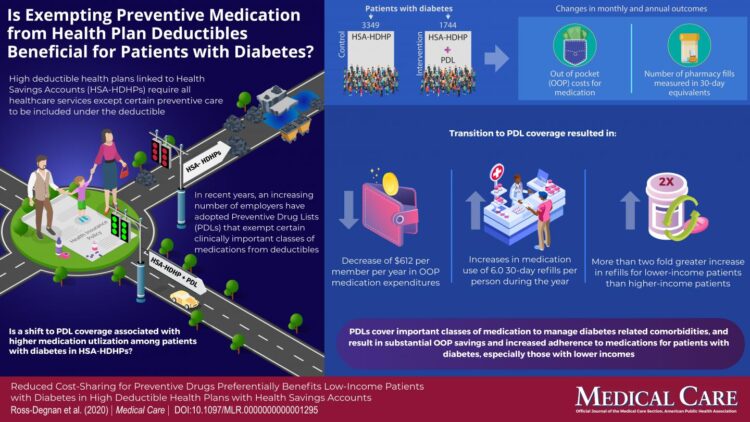Natural experiments help show ‘what works’ in improving diabetes outcomes, reports medical care

Credit: Ross-Degnan et al. (2020) / Medical Care / DOI: 10.1097/MLR.0000000000001295
May 27, 2020 – For patients with diabetes – especially those with lower incomes – preventive drug lists (PDLs) of essential medications available with no deductible can reduce out-of-pocket costs while increasing use of important treatments, reports a study in a June supplement to Medical Care. The journal is published in the Lippincott portfolio by Wolters Kluwer.
The special issue presents a series of “natural experiments” – evaluating how changes in healthcare policy or practice affect real-world outcomes in patients with diabetes – from the Natural Experiments for Translation in Diabetes 2.0 (NEXT-D2) Network. “Natural experiments are permitting us to take advantage of the rapid proliferation of big data to rigorously study the impact of policies that otherwise would go unevaluated,” comments Edward Gregg, PhD, of Imperial College, London, one of the co-leaders of the NEXT-D2 Network.
As Out-of-Pocket Costs Go Down, Use of Essential Treatments Goes Up
A growing number of Americans are covered by high-deductible health plans (HDHPs) – insurance plans with annual deductibles of $1,000 or higher – designed to reduce unnecessary care and promote higher-value care. But HDHPs include annual deductibles, copayments and other forms of cost-sharing, which can adversely impact treatment for diabetes and other chronic diseases, including use of needed medications. Adverse effects on medication use may be particularly large in federally regulated HDHPs linked to Health Savings Accounts (HSAs) that require patients to pay the full cost of medications until their annual deductible amounts are met.
To address this issue, some employers and insurers have developed PDLs specifying medications exempt from deductibles or copayments. Dennis Ross-Degnan, ScD, and colleagues of Harvard Medical School and Harvard Pilgrim Health Care Institute, Boston, evaluated a natural experiment to determine how these PDLs have affected out-of-pocket costs and use of clinically essential medications for patients with diabetes.
The study included 1,744 patients with diabetes enrolled in HDHPs with HSAs, whose employers switched all employees to PDL coverage. The switch meant that key medications and supplies for preventing the long-term adverse effects of chronic illness – including antidiabetic drugs, insulin, test strips, and blood pressure- and cholesterol-lowering drugs – became available with no or limited cost-sharing.
Analysis of insurance claims found that the PDLs led to a significant decrease in out-of-pocket medication costs: an average savings of $612 per year for patients with diabetes. This was accompanied by a sharp increase in preventive medication use: an average of six additional medication refills per year.
The increase in prescription refills was much larger for lower-income patients, for whom high cost-sharing may have been an important reason for previous underuse. The researchers also noted: “Overall savings in out-of-pocket spending were much larger for patients with severe diabetes, primarily due to savings on insulin.”
‘What Works’ in Diabetes Management – NEXT-D2 Papers Provide Insights
There are many promising strategies to improve care and prevent complications for the millions of Americans affected by diabetes. The eight NEXT-D2 projects in the special issue address initiatives related to health insurance expansion, including Medicaid expansion and community health centers; healthcare financing and payment models, such as HDHPs and new Medicare/Medicaid initiatives; and innovations in care coordination for patients with diabetes.
“These and other natural experiments in the NEXT-D2 collaboration are using existing health data to fill the knowledge gaps in terms of what works for preventing diabetes and its complications,” Dr. Gregg adds. NEXT-D2 is co-sponsored by the Centers for Disease Control and Prevention, the National Institute of Diabetes and Digestive and Kidney Diseases, and the Patient-Centered Outcomes Research Institute.
###
Click here to read “Reduced Cost-sharing for Preventive Drugs Preferentially Benefits Low-income Patients With Diabetes in High Deductible Health Plans With Health Savings Accounts.”
DOI: 10.1097/MLR.0000000000001295
About Medical Care
Rated as one of the top ten journals in health care administration, Medical Care is devoted to all aspects of the administration and delivery of health care. This scholarly journal publishes original, peer-reviewed papers documenting the most current developments in the rapidly changing field of health care. Medical Care provides timely reports on the findings of original investigations into issues related to the research, planning, organization, financing, provision, and evaluation of health services. In addition, numerous special supplementary issues that focus on specialized topics are produced with each volume. Medical Care is the official journal of the Medical Care Section of the American Public Health Association.
About Wolters Kluwer
Wolters Kluwer (WKL) is a global leader in professional information, software solutions, and services for the clinicians, nurses, accountants, lawyers, and tax, finance, audit, risk, compliance, and regulatory sectors. We help our customers make critical decisions every day by providing expert solutions that combine deep domain knowledge with advanced technology and services.
Wolters Kluwer reported 2019 annual revenues of €4.6 billion. The group serves customers in over 180 countries, maintains operations in over 40 countries, and employs approximately 19,000 people worldwide. The company is headquartered in Alphen aan den Rijn, the Netherlands.
Wolters Kluwer provides trusted clinical technology and evidence-based solutions that engage clinicians, patients, researchers and students with advanced clinical decision support, learning and research and clinical intelligence. For more information about our solutions, visit http://healthclarity.wolterskluwer.com and follow us on LinkedIn and Twitter @WKHealth.
For more information, visit http://www.
Media Contact
Connie Hughes
[email protected]





